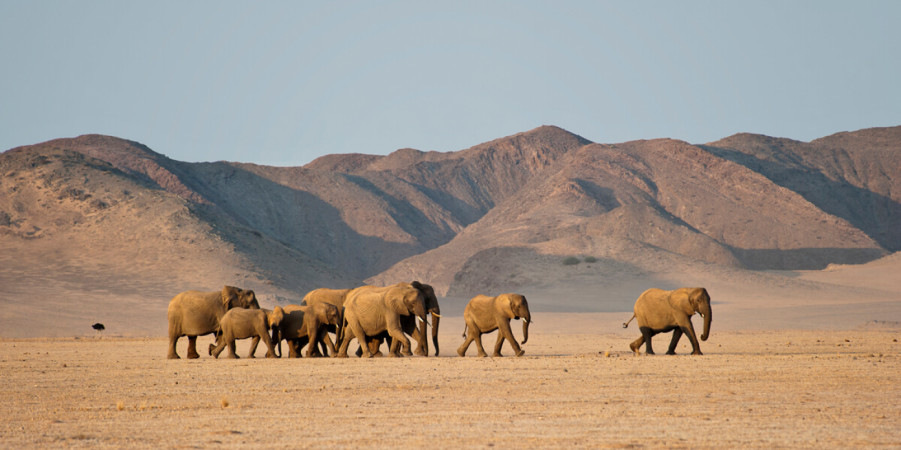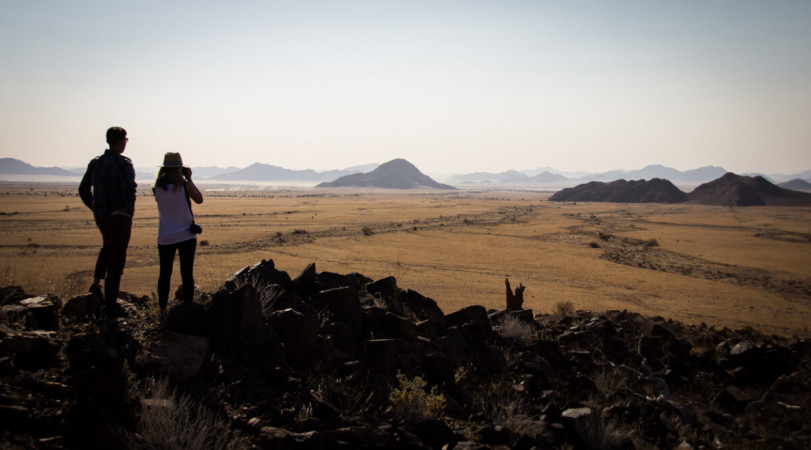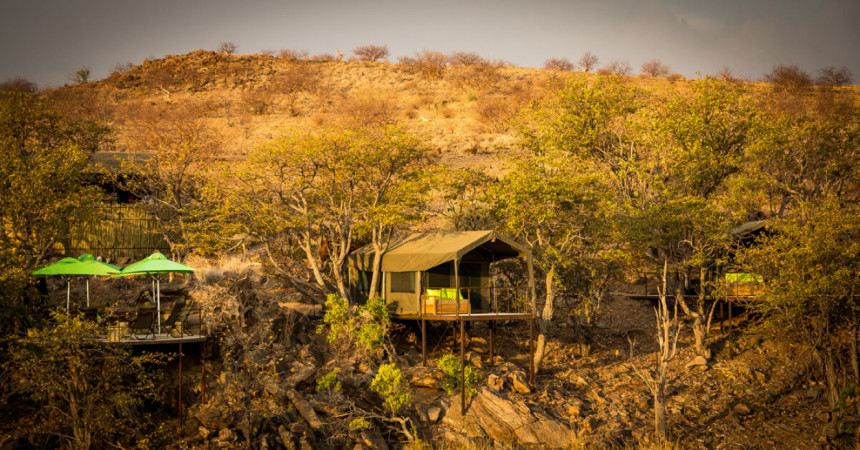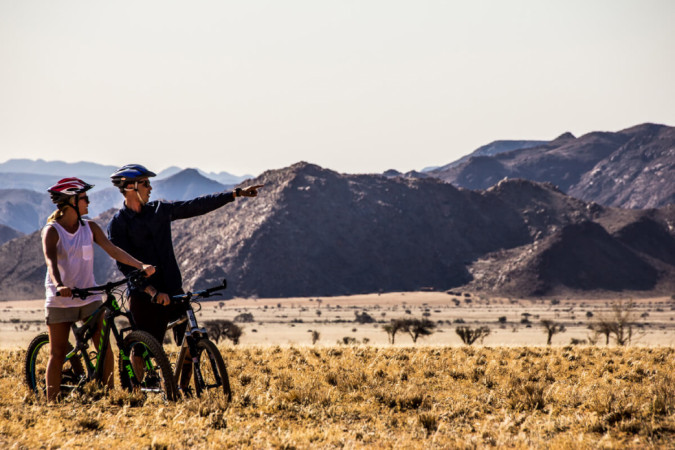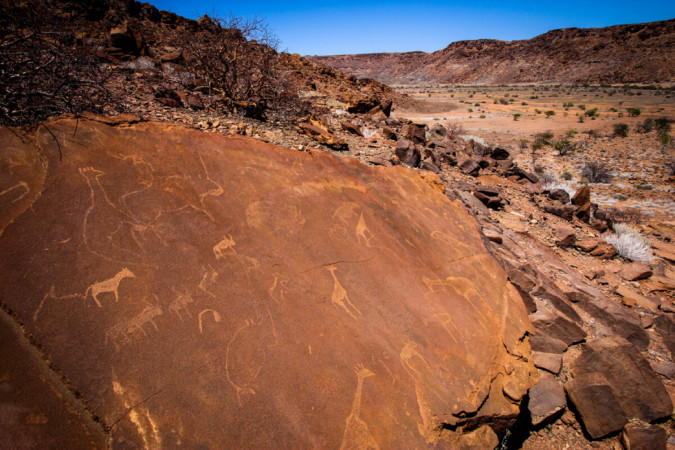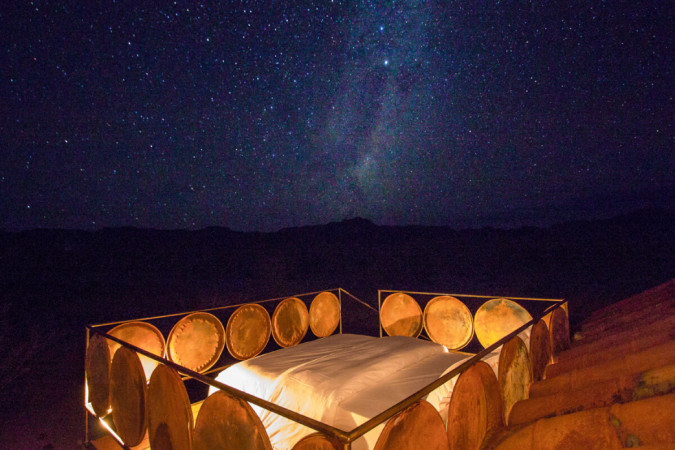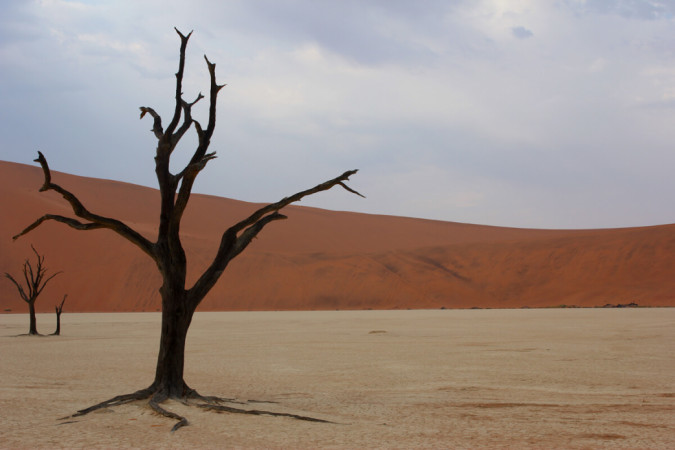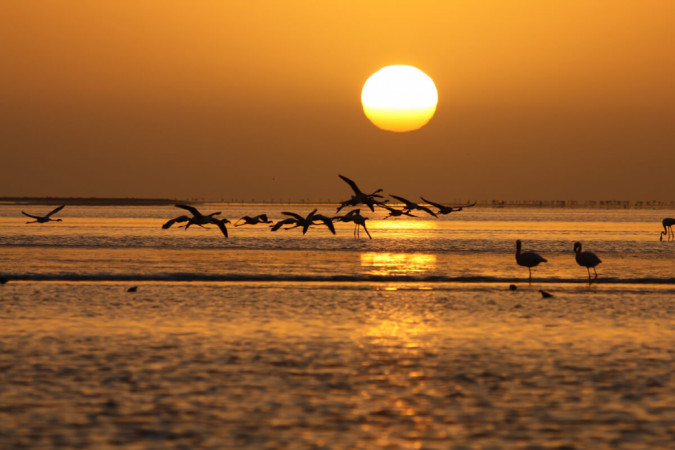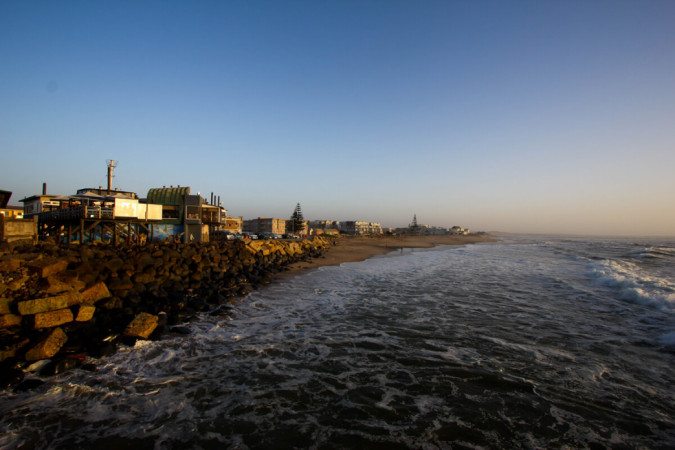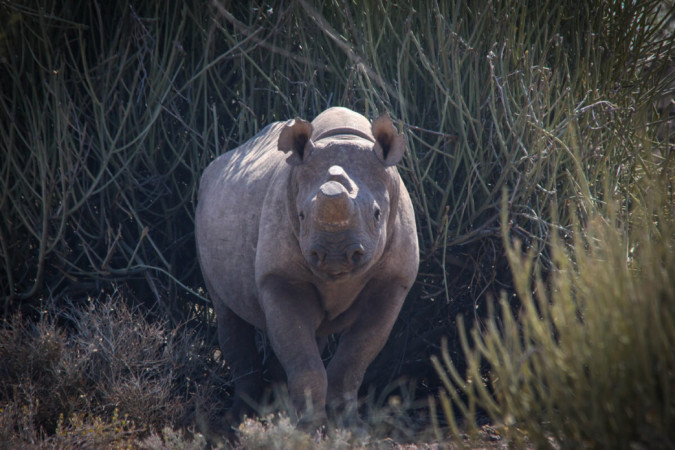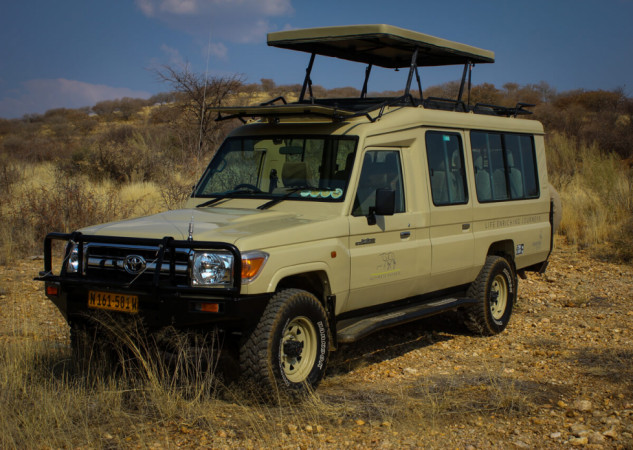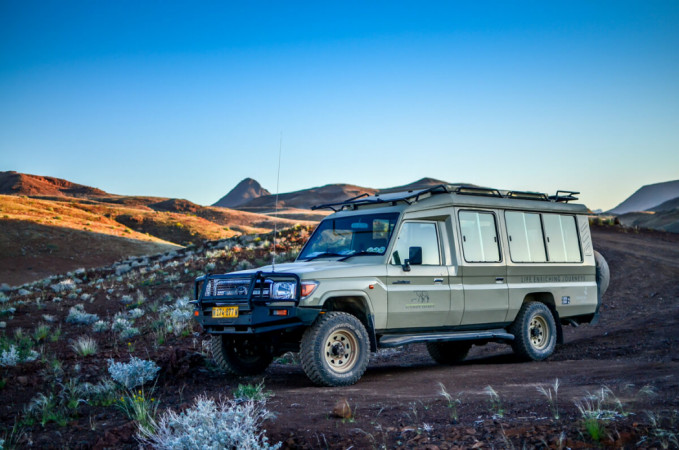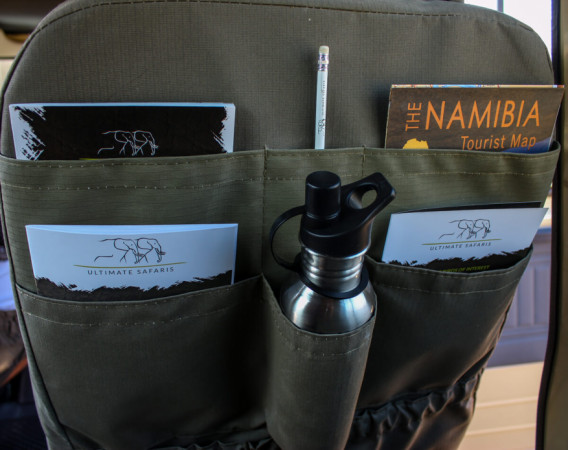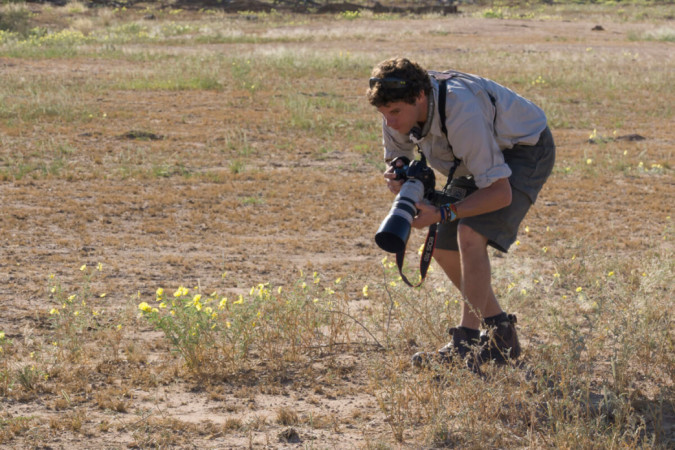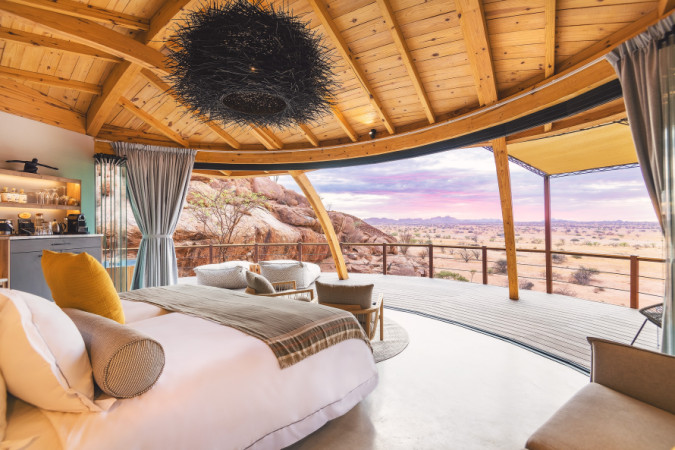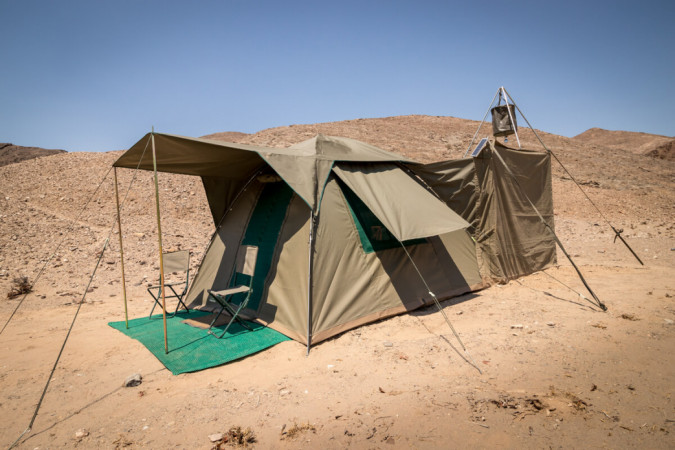Namibia Untold Safari
9 Day Guaranteed Departure Accommodated Safari In 2026
From N$ 96,329.00 pp sharing Minimum 1 Pax / Maximum 7 Pax
Namibia is a vast country, even by African standards, covering an area approximately twice the size of California and four times the size of the United Kingdom, but with a population of a mere 2 million. This gives one of the lowest population densities in the world. It is also an 'ageless land’; visible through our heritage of rock art created by stone-age artists and geological attractions such as the petrified forest where fossilised tree trunks have lain for over 280 million years. When added to the space and silence, these factors all contribute to a feeling of antiquity, solitude and wilderness. The climate is typical of a semi-desert country. Days are warm to hot, and nights are generally cool. Temperatures are modified by the high plateau in the interior and by the cold Benguela Current that runs along the Atlantic coastline. Except for the first few months of the year, the country is generally dry with very little rain.
The NAMIBIA UNTOLD SAFARI affords you the chance to experience this magnificent and memorable country in a very personal way. You will have your own professional and experienced safari guide who will enhance your enjoyment of this unique country by making it a fascinating and stress-free journey of discovery amidst very dramatic scenery. The knowledge, experience, and character of our guides are critical to a successful safari which is why we ensure that they are both personable and very professional. Your Ultimate Safaris guide will have an intimate knowledge of each area and camp/lodge that you visit, allowing him to share local insights and highlights whilst adding continuity and depth to your safari. Our guides know exactly what an immersive and life enriching journey is all about. All are highly experienced, and each has a specific area of expertise. They therefore possess the breadth and depth of knowledge to allow them to answer questions and satisfy the interests of each of our guests. The presence and company of your Ultimate Safaris naturalist guide will make your safari ‘an experience of a lifetime!
The camps and areas visited on this safari offer a truly immersive, remote, and largely private experience with the emphasis being on the experiential aspect allowing you to go back to the roots of safari, to touch, to smell, to feel and to experience the wild with your feet firmly in the dust that covers Africa. You will also have first hand experience of the impact that these camps have on the areas in which they are located, and to see some of Namibia’s successful conservation initiatives, including rhino conservation, community empowerment and the rewilding and protecting of desert landscapes. You will learn more about the ongoing research and conservation projects happening on the Etosha Heights Reserve, and you will also embark on a rhino activity supported by Save The Rhino Trust. In the latter, you will accompany Rhino Rangers searching for some of the last free-roaming black rhino population in a newly established blueprint conservation area, the Doros Joint Management Area, much of which is still very much NAMIBIA UNTOLD. Namibia is home to the only desert adapted black rhinoceros population that remains in the wild, unfenced and outside reserves, occupying an arid range in the western Kaokoveld.
You end your safari with a stay at a desert retreat on the Namib Tsaris Conservancy, which was founded in 2010, serving as a natural buffer from the harshest desert conditions and a refuge that is vital to wildlife through the dry season. Twelve years of intensive work to reverse sixty years of inappropriate farming practices, including the removal of 89 km of internal fencing, the installation of wildlife watering points, the improvement of road networks, the rehabilitation of land and the reintroduction of wildlife that historically occurred here has resulted in one of the most picturesque and ecologically sound tracts of land in the area.
Join us on a journey that is truly NAMIBIA UNTOLD
Trip Highlights
- Travel with one of Namibia’s most reputable and well-known naturalist guides
- Memorable and exciting guided game drives within the renowned Etosha National Park, from the vantage point of a specially modified, air conditioned 4x4 with pop tops
- Game drive on the private Etosha Height Reserve
- Explore the Damaraland region whilst staying at Camp Doros.
- Search for desert adapted elephant in ephemeral river systems.
- Track for the endangered black rhino in conjunction with Save the Rhino Trust.
- Visit and explore Namibia’s central coastal region with canyons, dunes and lagoons.
- Explore the private Namib Tsaris Conservancy on exploratory nature drives and guided walks whilst staying at Camp Sossus.
- Climb some of the world’s highest free-standing sand dunes at Sossusvlei and enjoy a magic box picnic in the Namib Naukluft Park afterwards.
- Enjoy spectacular star gazing of the Milky Way on the Namib Tsaris Conservancy.
- Enjoy refreshing moments in desert pools on the Namib Tsaris Conservancy.
Pre & Post Safari Accommodation & Transfers
Please contact us to arrange all your pre and post-safari accommodation in Windhoek or Okonjima as well as any airport transfers that may be needed. These are not included in the safari fare so they will have to be charged additionally. We recommend the following establishments in Windhoek; Galton House, Olive Grove Guesthouse and Am Weinberg.
In Brief
| Days | Summary |
|---|---|
| Day 1 | Arrive in Windhoek before 7am or ideally the previous day. Set off by road to Etosha Heights Reserve, Western Etosha National boundary |
| Day 2 | Game viewing within the Etosha Heights Reserve |
| Day 3 | Drive to Camp Doros, Damaraland |
| Day 4 | Rhino search with the assistance of local trackers |
| Day 5 | Discover the fascinating landscapes with your private naturalist guide both by vehicle and on foot. |
| Day 6 | Drive to Desert Breeze Lodge, Swakopmund |
| Day 7 | Drive to Camp Sossus, Sossusvlei |
| Day 8 | Rise early for a magical excursion with your guide to Sossusvlei in the Namib Naukluft National Park |
| Day 9 | Drive back to Windhoek |
In Detail
Day 1 - Windhoek to Western Etosha National Park
Overnight: Etosha Mountain Lodge | Includes: Breakfast, Lunch, Dinner & Etosha National Park Game drive with guide (local drinks included)
Day 2 - Western Etosha National Park
Overnight: Etosha Mountain Lodge | Includes: Breakfast, Lunch, Dinner and one morning and one afternoon game drive on the Etosha Heights Game Reserve in open game viewer with lodge ranger (local drinks included)
Day 3 - Drive from Western Etosha National Park to Damaraland
This morning after breakfast you will continue your safari to the heart of Namibia, Damaraland, traveling through farmlands and the small towns. Damaraland is typified by displays of colour, magnificent table topped mountains, rock formations and bizarre-looking vegetation. The present-day landscape has been formed by the erosion of wind, water and geological forces which have formed rolling hills, dunes, gravel plains and ancient river terraces. It is the variety and loneliness of the area as well as the scenic splendour which will reward and astound you, giving one an authentic understanding of the word 'wilderness'. You enjoy a delicious Magic Box picnic en route and arrive in time in time to enjoy fireside sundowners at Camp Doros. Please note that today is a long day of travelling, rewarded with another 3 night stay at your next camp.
Camp Doros: The camp is deliberately small and intimate, and it is located in a core area for desert adapted black rhino with activities largely focused on searchig for rhino with an experienced and qualified Rhino Ranger team. Camp Doros is perched on a high bank overlooking a (generally) dry riverbed and groves of Mopane trees in the heart of Damaraland. Protected from the prevailing winds, the camp carries arguably the lowest environmental footprint of any camp in Namibia. Six shaded guest tents (one of which is a family unit) are raised on platforms and have basic infrastructure including twin beds, cupboards, solar power for lighting and charging points, and some important comforts such as showers and en suite flush toilets. The camp also has a spacious common area including bar, dining room and lounge, as well as a welcome plunge pool. There is a focus on personalized service delivery, and this includes hearty and scrumptious meals which are prepared in a largely solar and wood-fired kitchen. The essence of the camp is ‘under canvas and experiential’.
Overnight: Camp Doros | Includes: Breakfast, Lunch, Dinner and nature based activities with Guide (local drinks & limited laundry included)
Day 4 - Damaraland
Today you will spend an exciting and memorable morning out searching for rhino with the assistance of local trackers. It is worth noting that these black rhino form part of one of the only free-roaming black rhino populations in Africa and looking for animals in an unfenced and uninhibited environment is an absolute privilege. You will return to camp for a freshly prepared lunch and with time to relax at camp during the heat of the day. Later in the afternoon you head out again for a scenic nature drive or walk to explore this vast and astounding ecosystem. Camp Doros works together with the Save the Rhino Trust (SRT) - an NGO that has been has been instrumental in the preservation of the rare, endangered, desert adapted black rhino. Having barely survived the slaughter in many parts of Africa during the '80s and '90s, the black rhino population of Namibia increased substantially since the formation of SRT.
Desert Black Rhinoceros: Namibia is home to the larger of two subspecies of the black rhinoceros found in southern Africa. The only population that remains in the wild, unfenced and outside reserves occupies an arid range in the western Kaokoveld. Their preferred habitat is the mountainous escarpment, but they follow ephemeral rivers into the northern Namib as well, especially when conditions are favorable after rains. They are the only black rhinoceros in Africa that are internationally recognized as a “desert group”. Like desert-adapted elephant, they cover great distances. They walk and feed at night and rest during the day. To meet their nutritional and bulk requirements they browse on no fewer than 74 of the 103 plant species that grow in their range. One of the few animals to eat fibrous Welwitschia leaves; they even feed heavily on the milkbush (Euphorbia virosa) with its sharp spines and toxic latex, presumably because of the high water and fat content. They are physical defenses of dryland plants without apparent harm. Once widespread in the subcontinent, black rhinoceros are an endangered species. The smaller subspecies, Diceros bicornis minor, does not range into Namibia.
Overnight: Camp Doros | Includes: Breakfast, Lunch, Dinner and nature based activities with Guide (local drinks & limited laundry included)
Day 5 - Damaraland
Today you continue your adventures exploring Damaraland, enjoying the freedom to discover the fascinating landscapes with your private naturalist guide both by vehicle and on foot. Damaraland is a surprising refuge for desert adapted wildlife that may include elephant, giraffe, oryx, springbok and even some predators such as lion. However, as with any wildlife sightings in Namibia, this depends on many factors including seasonality so specific sightings are never guaranteed. The wildlife roams large tracks of unfenced desert landscapes and finding game can be challenging, but this is all part of the adventure of exploring this wild untouched gem of Namibia. Today’s focus will be largely on searching for the elusive desert adapted elephants in the ephemeral river systems, an activity which will mean spending most of the day out. Your guide will take along a delicious picnic lunch and you will return to camp in the late afternoon.
Desert Adapted Elephant: In habitats with sufficient vegetation and water an adult elephant consumes as much as 300 kg of roughage and 230 liters of water every day of its life. Consider what a herd of them would eat and drink in a week or a month or a year. African elephant in a desert? Well, yes! Not only elephant, but other large mammals like black rhinoceros and giraffe as well. Their ranges extend from river catchments in northern Kaokoveld as far south as the northern Namib. Apart from the Kunene River, seven river courses northwards from the Ugab provide them with possible routes across the desert, right to the Skeleton Coast. The biggest are the Hoarusib, the Hoanib, the Huab and the Ugab Rivers. Desert adapted elephant in Kaokoland and the Namib walk further for water and fodder than any other elephant in Africa. The distances between waterholes and feeding grounds can be as great as 68 km. The typical home range of a family herd is larger than 2,000 km², or eight times as big as ranges in central Africa where rainfall is much higher. They walk and feed at night and rest during the day. To meet their nutritional and bulk requirements they browse on no fewer than 74 of the 103 plant species that grow in their range. Not a separate species or even a subspecies, they are an ecotype unique to Namibia in Africa south of the equator, behaviorally adapted to hyper-arid conditions. Elephant in Mali on the southwestern fringe of the Sahara Desert are the only others known to survive in similar conditions.
Overnight: Camp Doros | Includes: Breakfast, Lunch, Dinner and nature based activities with Guide (local drinks & limited laundry included)
Day 6 - Damaraland to Swakopmund
After an early breakfast and departure the drive today takes you south past Namibia’s highest mountain, the Brandberg which peaks at 2,573 m above sea level, and west to meet the coast at Henties Bay. You then continue south to the coastal town of Swakopmund where you can enjoy the pleasant seaside location and cooler coastal air for the night. You stay on the eastern outskirts of the town, overlooking the Swakop River valley and desolate desert dune landscapes. Tonight includes dinner at a popular restaurant which specializes in locally harvested fresh seafood as well as other local and international dishes.
Swakopmund: Swakopmund resembles a small, German coastal resort nestled between the desert and the sea. It boasts a charming combination of German colonial architecture blended with good hotels, shops, restaurants, museums, craft centres, galleries and cafés. Swakopmund had its beginnings as a landing station in 1892 when the Imperial Navy erected beacons on the site. Settlers followed and attempts to create a harbour town by constructing a concrete Mole and then iron jetty failed. The advent of World War 1 halted developments and the town sank into decline until half a century later when infrastructures improved and an asphalt road opened between Windhoek and Swakopmund. This made reaching the previously isolated town quicker and easier and it prospered once again to become Namibia’s premier resort town. Although the sea is normally cold for swimming there are pleasant beaches and the cooler climate is refreshing after the time spent in the desert.
Desert Breeze: Located on the banks of the ephemeral Swakop River and just a few minutes' drive from the centre of town, Desert Breeze provides the perfect escape to experience space, tranquility and serenity. There are twelve en-suite, luxury bungalows and one exquisite villa, each with a private sun deck to admire the breath-taking view of the dunes. Expressing sophisticated style and luxury from their accommodation right through to their breakfast facilities makes guests feel pampered and spoiled. Each bungalow and villa is equipped with wireless internet, mini bar, coffee and tea making facilities and digital safes. Only the freshest of produce is provided for breakfast and seating is available indoors or on the deck for guests to enjoy the view and peaceful atmosphere. Big basalt sculptures along with colourful and very unique architecture stand in contrast to the desert landscape, yet also compliments it. The creative luxury offered in the bungalows along with the friendly staff will make your stay very memorable .
Overnight: Desert Breeze | Includes: Breakfast, Lunch & Dinner (local drinks included)
Day 7 - Swakopmund to Namib Tsaris Conservancy, Sossusvlei
After an early breakfast you depart on a fascinating drive which takes you south-east through awesome and ever-changing desert landscapes via the impressive Gaub and Kuiseb canyons to meet the dunes at the settlement of Solitaire. A picnic lunch will be had en route and you will continue onto the Namib Tsaris Conservancy, where you will spend your final two nights of your safari at Camp Sossus. Arrival should be in the mid to late afternoon with enough time to acquaint yourself with the camp and enjoy a hot bucket shower before dinner.
NOTE: As an alternative to the drive from Swakopmund to Sossusvlei you may like to take a scenic light aircraft flight over Sossusvlei and along the Diamond Coast (optional extra at additional cost), allowing you a bird’s eye view over the Sandwich Harbour and salt pans, the Namib Sea Sand, abandoned mining camps and two shipwrecks,. Your guide will drive to meet up with you in Sossusvlei later in the day. Please note that if making use of this offer, flights will need to be booked exclusively with Ultimate Safaris for absolute logistical reasons.
Namib Tsaris Conservancy: The 24 000 hectare Namib Tsaris Conservancy was founded by Landscape Conservationist and Philanthropist Swen Bachran in 2010, and it serves as a natural buffer from the harshest desert conditions and a refuge that is vital to wildlife through the dry season. Eight years of intensive work to reverse sixty years of inappropriate farming practices, including the removal of 120 km of internal fencing, the installation of wildlife watering points, the improvement of road networks, the rehabilitation of land and the reintroduction of wildlife that historically occurred here, has resulted in one of the most picturesque and ecologically sound tracts of land in the area. The Conservancy has gravel plains, mountainous areas with dry river valleys as well as a large raised plateau which towers above the desert below, and it is now home to some of largest concentrations of wildlife in the area, including oryx, springbok, Hartmann’s mountain zebra, Burchell’s zebra, kudu, hartebeest, giraffe, steenbok, klipspringer, bat-eared fox, and aardwolf, as well as predators such as leopard, cheetah, brown and spotted hyena. Plans for the future which include the reintroduction of critically endangered black rhino and the acquisition of adjoining land are already well underway!
Camp Sossus: Located on the private 24,000ha Namib Tsaris Conservancy and nestled between the Nubib and Zaris Mountains, this camp is a mere thirty minutes’ drive from the Sossusvlei gate, the gateway to the Great Namib Sand Sea which has recently been declared a UNESCO World Heritage Site. The camp offers eight tents, two of which are family units, offering a fantastic alternative to any traditional lodge in the Sossusvlei area as it also offers exclusivity which is beyond compare. Activities include visits to Sossusvlei with your private guide and general exploration of the private Neuhof Nature Reserve, including nature walks and drives, magic moments in desert pools (yes, isn’t that intriguing) and star gazing. In addition to this, Camp Sossus provides a convenient base from which to go on hot air balloon flights as well as scenic helicopter and fixed wing aircraft flights over the local area. It is also a great venue for photographers, offering fantastic landscapes, iconic quiver trees, and the opportunity for night time photography which is often very difficult to arrange elsewhere.
Overnight: Camp Sossus | Includes: Breakfast, Lunch, Dinner and nature based activities with Guide (local drinks included)
Day 8 - Namib Tsaris Conservancy / Sossusvlei
This morning you will need to rise early for a magical excursion with your guide to Sossusvlei in the Namib Naukluft National Park, normally setting off before sunrise to enter the park at sunrise and capture the dunes whilst the light is soft and shadows accentuate the towering shapes and curves. The Sossusvlei area boasts some of the highest free-standing sand dunes in the world and your guide will give you an insight on the formation of the Namib Desert and its myriad of fascinating creatures and plants that have adapted to survive these harsh environs. Once you have explored Sossusvlei, Deadvlei and surrounding dune fields to your heart’s content you can enjoy a relaxed picnic brunch in the shade of a camel thorn tree.
You will return to camp for a late freshly prepared lunch and with time to relax at camp during the heat of the day. Later in the afternoon you head out again for a scenic nature drive or walk to explore this vast and astounding ecosystem and to enjoy a magnificent final safari sundowner.
Sossusvlei: This most frequently visited section of the massive 50,000 km² Namib Naukluft National Park has become known as Sossusvlei, famous for its towering apricot coloured sand dunes which can be reached by following the Tsauchab River valley. Sossusvlei itself is actually a clay pan set amidst these star shaped dunes which stand up to 300 meters above the surrounding plains, ranking them among the tallest dunes on earth. The deathly white clay pan contrasts against the orange sands and forms the endpoint of the ephemeral Tsauchab River, within the interior of the Great Sand Sea. The river course rises south of the Naukluft Mountains in the Great Escarpment.
It penetrates the sand sea for some 55 km before it finally peters out at Sossusvlei, about the same distance from the Atlantic Ocean. Until the encroaching dunes blocked its course around 60,000 years ago, the Tsauchab River once reached the sea; as ephemeral rivers still do in the northern half of the Namib. Sand-locked pans to the west show where the river previously flowed to before dunes shifted its endpoint to where it currently gathers at Sossusvlei. Roughly once a decade rainfall over the catchment area is sufficient to bring the river down in flood and fill the pan. On such occasions the mirror images of dunes and camel thorn trees around the pan are reflected in the water. Sossusvlei is the biggest of four pans in the vicinity. Another, famous for its gnarled and ghostly camel thorn trees, is Deadvlei which can be reached on foot over 1 km of sand. Deadvlei’s striking camel thorn trees, dead for want of water, still stand erect as they once grew. They survived until about 900 years ago when the sand sea finally blocked the river from occasionally flooding the pan.
Overnight: Camp Sossus | Includes: Breakfast, Lunch, Dinner and nature based activities with Guide (local drinks included)
Day 9 - Namib Tsaris Conservancy to Windhoek
After a leisurely breakfast this morning you will depart from Sossusvlei and return to Windhoek, driving northeast up the Great Escarpment and through the scenic Khomas Hochland highlands. A tasty picnic lunch will again be served en route and arrival in Windhoek should be by the mid-afternoon.
Upon your arrival in Windhoek you will be transferred to your accommodation establishment of choice, or out to the Windhoek International Airport (transfer to be booked additionally) if flying out in the evening - departure flights must be no earlier than 18h00 to allow sufficient time for the journey back to Windhoek, or a final night in Windhoek can be arranged at additional cost if required. A final night in Windhoek is highly recommended!
Includes: Breakfast & Lunch
Departure Dates
Apr 2026
NUS #1 03 Apr - 11 Apr 2026 N$ 21,684.00 single supplement (USD | EURO)
NUS #2 24 Apr - 02 May 2026 N$ 21,684.00 single supplement (USD | EURO)
May 2026
NUS #3 15 May - 23 May 2026 N$ 21,684.00 single supplement (USD | EURO)
NUS #4 22 May - 30 May 2026 N$ 21,684.00 single supplement (USD | EURO)
Jun 2026
NUS #6 19 Jun - 27 Jun 2026 N$ 21,684.00 single supplement (USD | EURO)
NUS #5 12 Jun - 20 Jun 2026 N$ 21,684.00 single supplement (USD | EURO)
Jul 2026
NUS #7 03 Jul - 11 Jul 2026 N$ 21,684.00 single supplement (USD | EURO)
NUS #8 24 Jul - 01 Aug 2026 N$ 21,684.00 single supplement (USD | EURO)
Sep 2026
NUS #11 18 Sep - 26 Sep 2026 N$ 21,684.00 single supplement (USD | EURO)
NUS #10 11 Sep - 19 Sep 2026 N$ 21,684.00 single supplement (USD | EURO)
Oct 2026
NUS #14 23 Oct - 31 Oct 2026 N$ 21,684.00 single supplement (USD | EURO)
NUS #13 02 Oct - 10 Oct 2026 N$ 21,684.00 single supplement (USD | EURO)
Gallery

Our Retreats
Our retreats are conservation impact investments, pioneering environmental sustainability, community development and conservation.
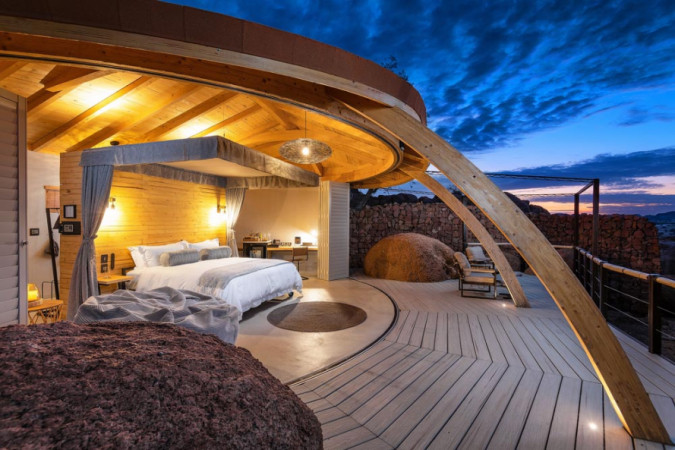
Onduli Ridge
Signature Retreat
Onduli Ridge, named after the resident giraffe of the area, is built at the base of two south facing granite outcrops which are connected by a ridge.
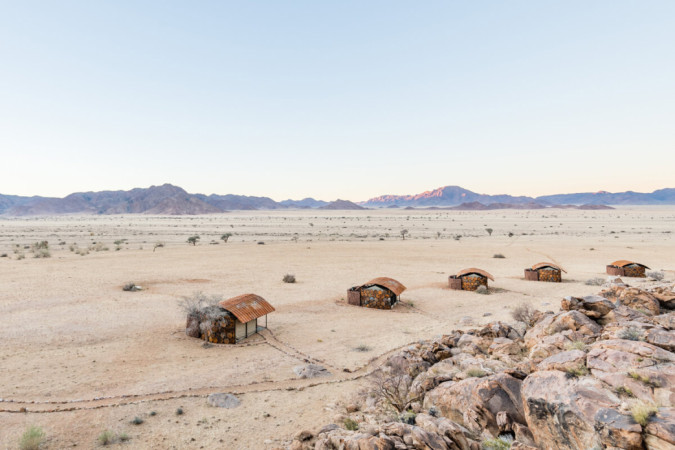
Camp Sossus
Immersive Exploration Retreats
Camp Sossus is built in a naturally formed amphitheatre of a south-facing granite outcrop within striking distance of So
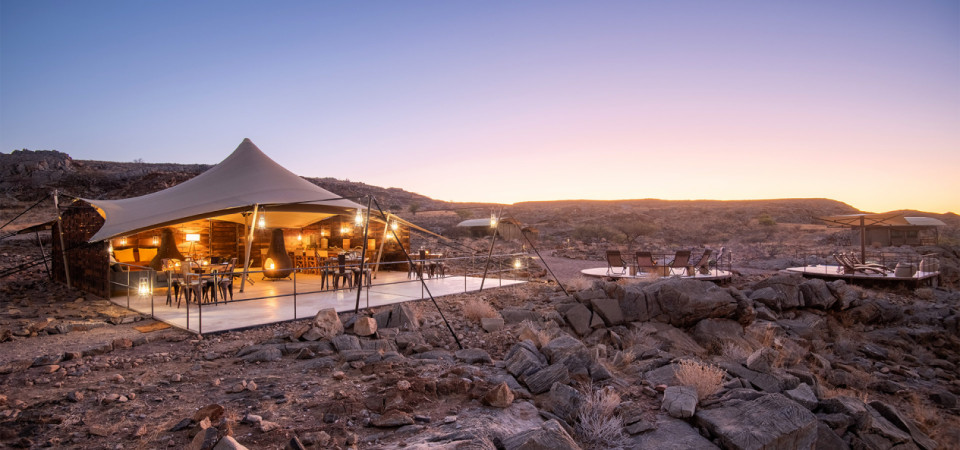
Camp Doros
Immersive Exploration Retreats
Camp Doros is deliberately small and intimate, and it is located in a core area for desert adapted black rhino with activities largely focused on finding the black rhino with an experienced and qualified Rhino Ranger team.
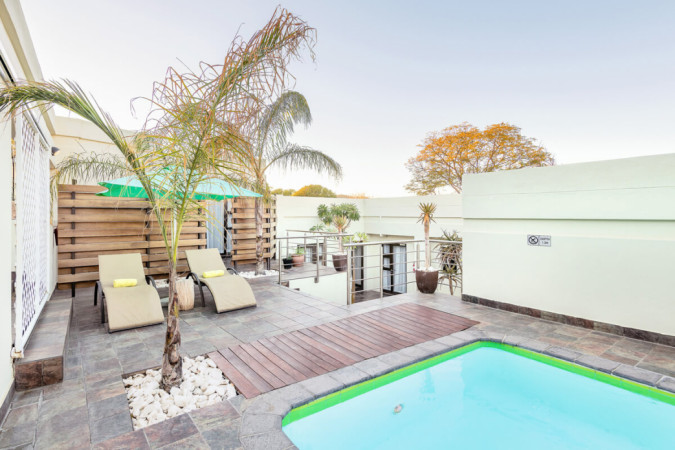
Galton House
Urban Retreat
Located in Windhoek and named after the famous explorer Sir Francis Galton, Galton House has a relaxed but efficient sty
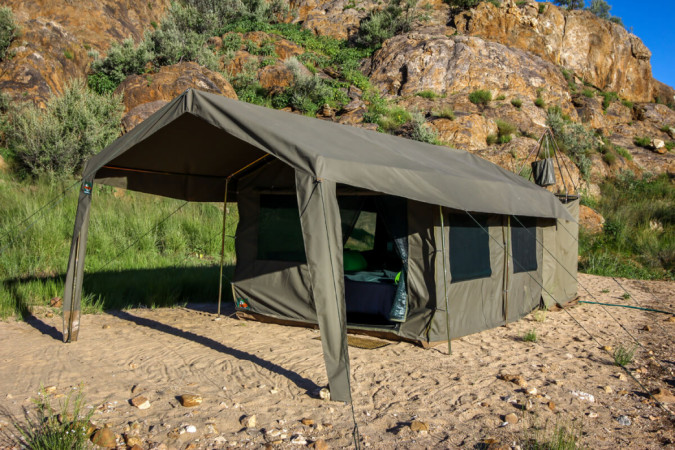
Meru Camp
Mobile Retreat
Rectangular Meru tents (4m x 3m and 2.5 m high) with built in groundsheets and mosquito screens on all doors and windows
